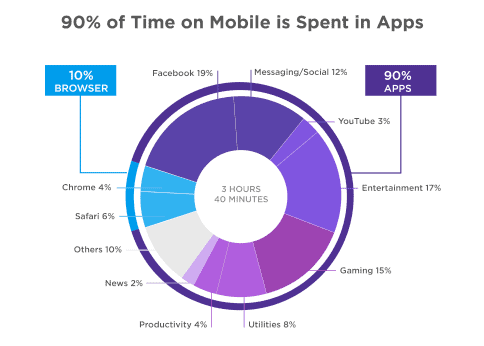Last updated on March 2nd, 2022 at 05:00 pm
In order to increase local foot traffic, build momentum and keep your customers coming back, owners should be aware of how to increase business sales. With tight budgets and a limited number of hours in a day, small business owners must find ways to remain successful and stay ahead of their competition. New small businesses, in particular, have to do everything possible to remain strong in their marketing campaigns for the future, despite having fewer resources.
There are a number of ways that small businesses can position themselves more strategically to better compete in the local market. Streamlining access to local small business information is an excellent place to start.

Optimize for Local Search & Mobile Search
Consumers use search engines to locate local businesses and find local information. Consumers who searched online for a local business, on a daily basis, more than doubled in 2018.
Improving your small business’ local search engine optimization (SEO) will generate more traffic, leads, and local business sales. Search engines, like Google, have made it easier for consumers to find local businesses. Owners should look into location-based ads to increase sales. Consumers prefer ads and search results that are relevant to their current location.
Local Search Listing
One of the easiest ways to improve your business sales is to secure your local listing. A local listing on Google or Bing lets you manage and own key information pages on the web whenever customers search for you, all free of charge. Your business will show up as a prominent result in search engines. You will also appear on all the available syndicate platforms (such as Google Maps, Google+, etc.). Customers will be able to provide ratings and reviews, which will allow you to build a relationship with them – a key tactic to increase small business sales.
Use Local Keywords
Use “keywords + location” on your site’s title page and heading, and naturally incorporate it into your content. This will help anchor your business to your target area. Before you do this, however, make sure to research the most relevant keywords for your business.
Make Your NAP Consistent
Make sure your NAP (name, address, and phone number) are consistent on every website where it is listed. Consistent data increases your local visibility. Avoid providing incorrect data, which can leave customers confused and searching for your business details.
Add Local Citations
Local citations are important so that search engines can provide users with the correct information. A local citation is any website that mentions your business, includes your business contact information, and your website. Citations can be made using business directories, local directories, and social media profiles. Examples of local citations include:
- TripAdvisor
- Foursquare
- Yelp
- Local newspaper websites
- Local blogs
If your NAP is consistent across all of your local citations, search engines will be more confident they are providing users with the correct information.
Use Local Social Media Advertising (Geotargeting)
Refining your target audience is a great way to increase small business sales while lowering marketing costs. This can be effectively done with geotargeting. Geotargeting delivers content to users based on their geographic location. It can be very advantageous to focus and restrict your ad(s) only to people living in your local area. After all, no matter what you sell, if you’re a small business dependent upon local traffic, you need to target that demographic specifically. Geotargeting is available on social media such as Facebook Ads, Twitter Ads, LinkedIn Ads, and Snapchat Ads.
Add Structured Data
Structured data markup contains details, such as your: business name, address, phone number, logo, website address, and opening hours. Additional information you may want to include in your code are:
- Types of payment accepted
- Price range
- Email address
- Geographical coordinates of your business
- A slogan
- The type of business you own
Structured data markup uses a shortcode that is placed in your website code. You can create structured data markup code for your business and put it in your site’s code or request your web development team to do so for you.

Pay Attention to Existing Customers & Their Feedback
Observe and take into account how your customers use and interact with your products and services. Try to understand what features they rely on or struggle with most and consider this a starting point for improvement. Offering training or more personalized products or services can help enrich your relationship with your customers. Take the time to work on your customer relationships rather than seeing this as an opportunity for an upsell. Your customers will be grateful and more satisfied with a 1-on-1 session without any additional costs.
Inform your customers what services and products your business offers and gather any inquires on what products or features they are seeking. Perhaps if they have a good product idea that your business lacks, you can incorporate it or have it available in the future. Consider this a valuable experience for both parties as well as a zero-cost method for your business to increase its sales.
Feedback from Your Current Customers
Customer insight is vital to increase small business sales. And the best and easiest way to understand what your customers want is to listen to them and address their needs. Having open channels of communications strengthens your relationships with existing customers and can bring in new customers. Your business may be able to address their needs rather than have them look for those products or services at a competing store. Offering a broader range of services where customers show interest can help. Listening to your customers and resolving their frustrations can lead to increased sales and more satisfied customers.
Referrals
Your existing customers can provide your small business with customer referrals. Usually, these referrals are spontaneous, but businesses can use strategies or incentives to increase referrals. You can provide rewards such as discounts or redeemable points for current customers that provide referrals.
You can also ask satisfied customers for the names and contact information of other small businesses that can mutually benefit from working with you. You can even ask for testimonials that you can use on your website or on social media. Testimonials build your brand’s reputation so that new customers can know what to expect.
Customer Loyalty Program
One of the quickest to increase sales is to create a customer loyalty program. You can increase your sales without needing to acquire new customers. A customer loyalty program can increase the frequency of purchases and the total amount spent on purchases. Having a customer loyalty program can be as simple as using a punch card, and offering a free item after ten purchases. Or your business can have a more complex customer loyalty program that simultaneously collects data. You can track customer spending and offer discounts after a target amount is reached.
Limited Sale or Promotion
Offering a sale or promotion for a set amount of time can attract new customers or appeal to current customers. Even a slight discount can be beneficial. Have very clear parameters for your sale or promotion, so there aren’t any misunderstandings, and you can continue gaining your customer’s business even after the sale ends. Although discounts seem antithetical to your goal, limited time sales and short promotions can actually help increase your overall sales. It can also grow your customer base by attracting new customers who are drawn to your promotional offers.
Blog About the Local Area
Another tactic for success is to develop a blog for your business. Blog articles on your website about your local area can increase your traffic and promote sales. Most importantly, it gives your business a chance to create a relationship with the local community. It will provide you with you an opportunity to connect with other individuals and businesses in the local area. Blogging about local events in your area will also increase your local search visibility. Using your local area as a keyword in these new blog articles is an excellent way to increase local visibility, thereby boosting local sales.
Have a Mobile Compatible Business
Mobile-Friendly Website
Your website should work well on mobile devices if you plan on showing up on local searches. While mobile-friendly websites are fairly commonplace, there are still some businesses whose websites don’t work well on mobile devices. This can frustrate users and potential customers. Rather than pursue your site on another device, they will likely abandon their attempt and leave your site for one that is easier to read and navigate. This is true whether you’re selling a service or a product.

Launch a Mobile App
The majority of customers on mobile devices prefer spending time in apps versus in a browser. If your business doesn’t already have an app, it’s something to consider.

Most consumers, about 63 percent, prefer using an app versus a mobile site because of its convenience. Fifty-seven percent of users prefer apps over mobile sites because they tend to be faster. Your app can also personalize your customer experience, facilitate your customer loyalty program, and promote your customer referral program.
Take Advantage of Google to Employ These Strategies

Google is placing a greater emphasis on local search with prominent local results appearing at the top of targeted search queries.
Create a local search listing for your business on Google. You can set up a free Google business profile with Google My Business.
Google My Business allows you to easily connect with customers through Google Search and Google Maps.
Your Google business profile will have all your contact information, including your: address, phone number, hours, directions, and link to website. You can also add photos.
Google My Business can cross reference your business details that appear on your website, social media profiles, and local citations.
You can use Google’s Structured Data Markup Helper to create structured data markup code for your website.
One of the best sources for reviewing mobile marketing statistics is Google Consumer Barometer. Google’s Consumer Barometer enables users to create reports that are useful for marketing research specialist and for businesses of all sizes. You can review statistics for your local area and compare them to different areas.

Google AdWords
Google AdWords is a powerful marketing platform and can be an asset to customer acquisition. It gives advertisers the ability to promote ads to users who search for specific keywords- within a particular geographic area – and who fit within specific behavioral criteria.
You might want to consider pay-per-click (PPC) options like AdWords for your small business. The pay-per-click model charges you after a customer clicks on your advertisement and reaches your website. You can optimize your PPC to target affordable and actionable keywords in certain geographical areas. You can get your ads in front of highly targeted keywords in your local marking, thereby increasing your conversion rate.
Google Alerts
You can monitor what is being said about your business online by using Google Alerts. Your business will be emailed anytime your local business or other keywords are published on a website. Google Alerts allow you to stay on top of the latest news, both positive and negative. If something negative is posted about your business, you can see it immediately- and try to get ahead of it rather than getting blindsided with this unfavorable news weeks later. If something positive is published about your business, you may consider sharing it on your website or social media.
Google Reviews
Customers can add photos of your business. They will be able to write reviews about your local business. Customer reviews have a huge impact on local businesses. Eighty-six percent of consumers read reviews for local businesses.

Reviews influence a significant proportion of consumers’ decisions. Over the past year, there has been little change in this. Positive reviews make 68 percent of consumers more likely to use local businesses. Negative reviews prevent 40 percent of consumers from wanting to use a local business. Seventy-eight percent of consumers trust online reviews as much as personal recommendations.
Consumers evaluate business reviews in 4 ways:
- The number of reviews
- The review ratings – having a lot of 5-star ratings will be more impressive than 1-star ratings
- The timing of your reviews—recent reviews look better than reviews that are over six months old
- The activity level of the reviewer—more activity in a reviewer’s history is better and more trustworthy to consumers than a reviewer who has only left a couple of reviews and is not an active contributor
Verify Your Information on Yelp
In addition to your Google listing, your local business will have online profiles on other platforms, whether you signed up for them or not. You may have a Yelp profile because customers wanted to write a review about your business. Even though you may not have started this profile, it’s important to make sure the information on such sites is correct. The best way is to claim your business on Yelp so you can change the information as needed. You can also add pictures and respond to reviews.

Approximately 92 percent of consumers make a purchase after viewing Yelp. Forty-two percent of consumers will purchase the same day and 79 percent of consumers will purchase within a week after viewing your business on Yelp.
Final Words
It
can be difficult to navigate a small business with the increasing saturation of
local markets and upsurge of technology. As a small business owner, you have to
stay flexible with your sales approach and embrace new trends in technology.
Always keep in mind your business values and your vision even as your small
business continues to adapt in order to remain competitive. Marketing your
small business online, in person, and within your community is an ongoing
process. With the help of online platforms and synchronization between
platforms, keeping up with change isn’t as daunting as it may first appear.
Even on a budget, there are free and low-cost strategies your business can use
to keep its competitive edge.

Shop Saddle Stitch Booklets at Printivity 
Shop Postcards at Printivity 
Shop Folders at Printivity




